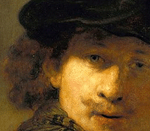
"The Nativity with the Prophets Isaiah and Ezekiel"
The greatest exponent of Sienese painting between the last quarter of the thirteenth and the first two decades of the fourteenth century, Duccio is documented for the first time in the role of painter in 1278, when he was paid by the Comune of Siena for the decoration of twelve coffers (casse) for the conservation of documents. Although this cannot have been a work of any particular artistic distinction, we may assume that the civic authorities would have chosen an artist who was already prominent in the city and in charge of a thriving workshop. Duccio is further recorded in Siena in 1279 and 1281, and then almost annually from 1285 onward.
Some inferences can be drawn about his youthful career on the basis of his first documented panel painting, the altarpiece “ad honorem beate et gloriose Virginis Marie,” commissioned on April 14, 1285, by a Florentine confraternity, the Compagnia dei Laudesi, for Santa Maria Novella in Florence — the so-called Madonna Rucellai, now in the Uffizi, Florence. The strongly Cimabuesque character of this work is distinguished by a more intimate and lyrical interpretation of the subject and by more studied calligraphic elegance of line and rich decorative patterning that recall the refinement of French and English Gothic painting of the period. This suggests the existence of close relations between the leading Florentine master and the young Sienese painter in the first half of the 1280s.
Duccio presumably spent the years 1280 – 1285 in Rome. This is evidenced by a single work, the painted cross formerly in the Castello Orsini at Bracciano (near Rome) and now in the Salini collection near Asciano in the province of Siena. Evidence of the artist’s encounter with classical and postclassical figurative culture in Rome is also clearly visible in the great stained-glass rose window (Dormition, Assumption, and Coronation of the Virgin and Saints) in Siena Cathedral, based on a design by Duccio and likely dating to the late 1280s. Thereafter the master probably spent his career permanently in his hometown, where he began producing precious small devotional paintings for high-ranking private patrons.